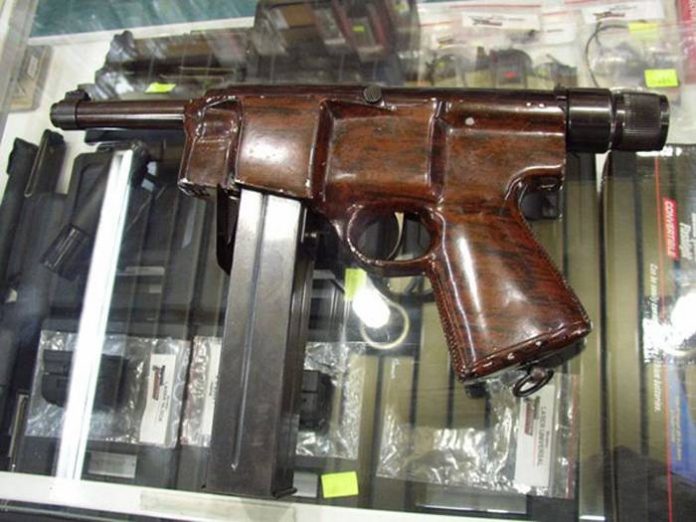
At the very beginning of the thirties, the Argentine gunsmith Juan Lenar developed first draft of a submachine gun. These weapons, Despite all its advantages, did not interest the army. Nevertheless, the refusal of the military did not force the engineers to stop working in a promising direction. A few years later, the results of its activities in the field of submachine guns were presented by the company HAFDASA. The first of her own development of this kind was a product called C-2.
In the mid-thirties, the Spanish-Argentinean joint venture Hispano-Argentina Fábrica de Automóviles S.A. (HAFDASA), previously engaged exclusively in automobiles, decided to try my hand at small arms. This activity began with the copying and refinement of the American Colt M1911 pistol.. Soon, the designers of the company, led by an engineer of French origin Roris Rigaud, began to develop their own projects., some of which offered the production of promising submachine guns.
According to some reports, work on the topic of submachine guns started with the study and copying of one of the existing foreign samples. With a little experience, HAFDASA designers began to develop their own project of a similar weapon. It was planned to use some ideas, spied on by foreign colleagues. At the same time, new solutions of one kind or another were proposed., capable of the most noticeable increase in the basic characteristics of weapons. For example, a high-capacity ammunition supply system was developed. In foreign projects, such funds appeared only after a few years..
The project of the first own submachine gun from HAFDASA received the working designation C-2. According to some sources, letter "C" meant Criolla - "native" or "local". Couple, in its turn, indicated the serial number of the project. As far as, the designation C-1 remained with the previous copy of foreign weapons. Also the line of weapons from the HAFDASA company is known under the general name Ballester-Rigaud. This name reflects the names of the chief designer Roris Rigo and the head of the development company Arturo Ballester.
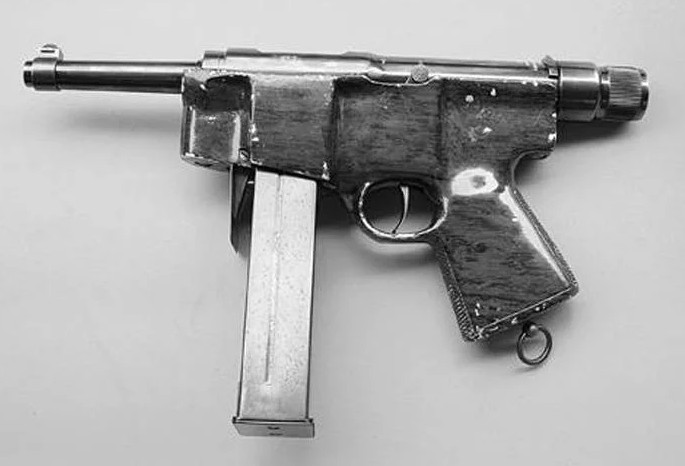 General view of the submachine gun C-2.
General view of the submachine gun C-2.
The HAFDASA C-2 project proposed the manufacture of a compact submachine gun with sufficiently high fire characteristics and maximum ease of operation.. Interesting, that within the framework of one project it was planned to develop two unified samples for different cartridges. The first version of the C-2 was supposed to use 9x19 mm "Parabellum" ammunition, second - .45 ACP. In this way, two submachine guns could differ in barrels, shops and some features of automation, while the rest were almost the same.
The C-2 product in a certain way stood out against the background of other submachine guns of that time.. Argentine engineers decided to reduce the size of the weapon to a minimum and thereby facilitate its operation.. In this case, the traditional layout with the barrel extended forward was used., lower magazine and pistol grip fire control. Simultaneously weapons of classic layout have received an unusual stamped aluminum fittings. obviously, the automotive company preferred to use already mastered technologies and do without wooden parts.
Regardless of the type of chuck used, HAFSADA's C-2 submachine gun was supposed to have a rifled barrel length 105 mm. When using the "Parabellum" cartridge, the relative length of the barrel was 11,6 caliber, in case of .45 ACP – 9,2 caliber. The barrel of the weapon looked like a pistol. It had a cylindrical outer surface with bulges at the muzzle and breech. The front bulge served as the base of the front sight, and the rear was intended for installation in the receiver.
As can be seen from the available data, all the main parts of the submachine gun were placed in the receiver, to a certain extent resembled rifle assemblies of that time. To install the shutter and other automation parts, an upper tubular casing was used. The trunk was fixed in front of it. for nim, top right, there was a window for ejection of spent cartridges. On the left side, a slot was provided for the withdrawal of the bolt handle. The rear end was completed with a cover, threaded.
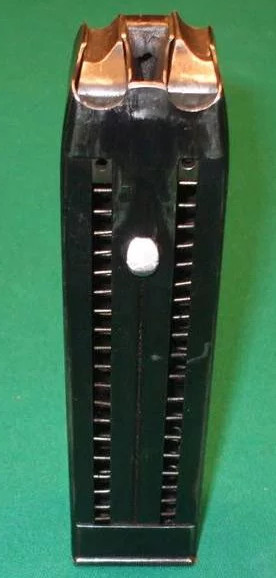 Double shop under a cartridge of 9х19 mm «Couple».
Double shop under a cartridge of 9х19 mm «Couple».
From below, a small-width unit was attached to the tubular part of the receiver, containing all the necessary details, from the magazine receiver to the firing mechanism. Due to original proposals, implemented in the ammunition supply system, the front of this part was distinguished by an increased width.
The HAFDASA C-2 product received the simplest automation, based on the free shutter principle. A cylindrical bolt was placed behind the breech of the barrel inside the box, backspring. Two bolts and a pair of springs were developed, the mass and characteristics of which corresponded to the energy of 9-mm and 11.43-mm cartridges. In the rear part of the shutter, the installation of the control handle was provided., withdrawn to the right side of the weapon. This handle had a rigid connection with the bolt and moved when firing.
There is no exact information about the design of the firing mechanism., but there is reason to believe, that the C-2 project used the simplest system. Submachine guns of that time were mostly fired from an open bolt., and a significant number of samples did not have a single firing mode. Quite possible, that the first sample from HAFDASA also had similar design features. Fire control was carried out using a traditional trigger design. The handle of the fire safety-translator was on the left side of the weapon, behind the receiver. She could move back and forth.
Roris Rigo and his colleagues proposed the original ammunition system, which made it possible to obtain a remarkably large ammunition while maintaining acceptable dimensions of the weapon. To achieve the desired characteristics and capabilities, certain innovations had to be made in both the design of the stores., and into own devices of the submachine gun. This problem was solved in a curious way., and all the products of the new line received the most interesting opportunities.
For storage and supply of cartridges, it was proposed to use detachable box magazines of a special design.. The store was very wide, which made it possible to place two parallel rows of cartridges in it. Each of the rows was located strictly vertically and served by its own spring-loaded pusher. The top section of the store was made in this way, which formed a pair of separate feeders. In fact, the new store was two separate devices., made in one building. There were a pair of round protrusions on the front and back walls of the store., interacting with weapon mounts.
For two modifications of the submachine gun, two types of magazines were created. A sample for ammunition 9x19 mm contained 50 rounds, by 25 pieces in each row. Larger cartridges .45 ACP required the use of an oversized body. At the same height, as in the case of the store under "Parabellum", shop for .45 ACP accommodated 40 cartridges - two rows of 20 pcs.
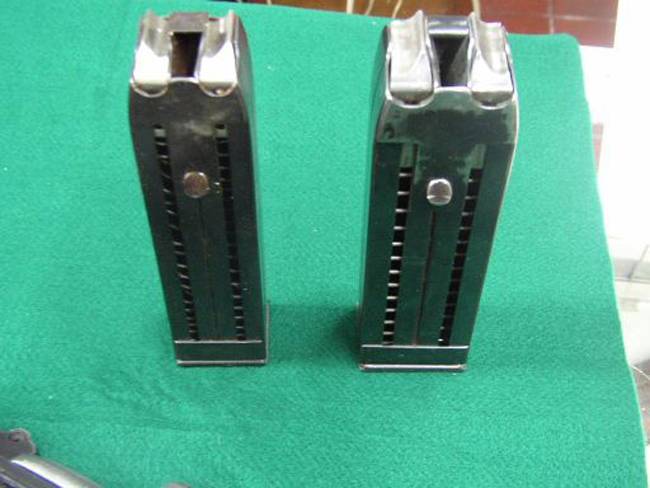 HAFDASA stores for different types of cartridges.
HAFDASA stores for different types of cartridges.
Submachine gun, designed for an unusual store, received non-standard receiving devices. At the bottom of the receiver, just behind the breech, placed a rectangular receiver of increased width. In front of him was a swinging cover with a hole for the front ledge of the store.. In the absence of the latter, the cover covered the large receiver. The rear protrusion of the store was placed in the hole of a separate plate, located behind the receiver. Besides, a separate latch was provided for fixing the store in one of two working positions.
Installed in the receiver, the store could swing on the axis, formed by the front and rear protrusions. This made it possible to alternately use cartridges of one and the other row.. To use one row, the store had to be rotated in a vertical plane and transferred to a tilted working position. According to some reports, retraction of the lower part of the store to the right made it possible to bring the left row of cartridges into working position and vice versa. Having spent half ammunition, the shooter had to open the lock and turn the store in a different direction, after which the supply of cartridges of the second row began. The simultaneous supply of cartridges from two rows was not provided.
The HAFDASA C-2 submachine gun in a known configuration had the simplest sights. A small front sight was placed on the muzzle of the barrel. In the back of the receiver, directly in front of the lid, there was an unregulated rear sight. This sight made it possible to fire at short distances., however, it could limit the real capabilities of the weapon. However, further, as the project develops, submachine gun could get a better sight.
The prototype of the C-2 submachine gun received a very interesting fittings., not quite typical for weapons of this class. The receiver, along with all the devices, was mounted on a stamped aluminum stock of a complex shape.. The latter contained a significant part of the details., above its upper cut was only a small section of the tubular casing of the receiver.
Another interesting feature of the box was the shape of the side surfaces.. Due to the wide receiver, designed for swinging shops, the side surface of the box consisted of four separate sections, located at different levels. There was a pistol grip in the back of the wooden part., in front of which was the trigger guard. curious, that the protective bracket was made in one piece with the stock. One can imagine, how much time and time did the gunsmiths spend on making molds for stamping such accessories.
The new weapon was small in size., which made it easier to carry. It was proposed to fix the belt on a swivel ring, placed on the bottom of the pistol grip. The second ring at the front of the weapon was not used.
Submachine gun C-2 from Hispano-Argentina Fábrica de Automóviles S.A. distinguished by its small dimensions. Weapon total length, not equipped with a butt, was 300 mm with 105 mm barrel. The weight of the product did not exceed several kilograms. According to reports, a product with a free shutter could show a rate of fire at the level of several hundred rounds per minute. The muzzle velocity of a 9-mm bullet reached 360 m / s. Larger bullet cartridge .45 ACP showed similar characteristics. Effective fire was provided at ranges up to 150-200 m.
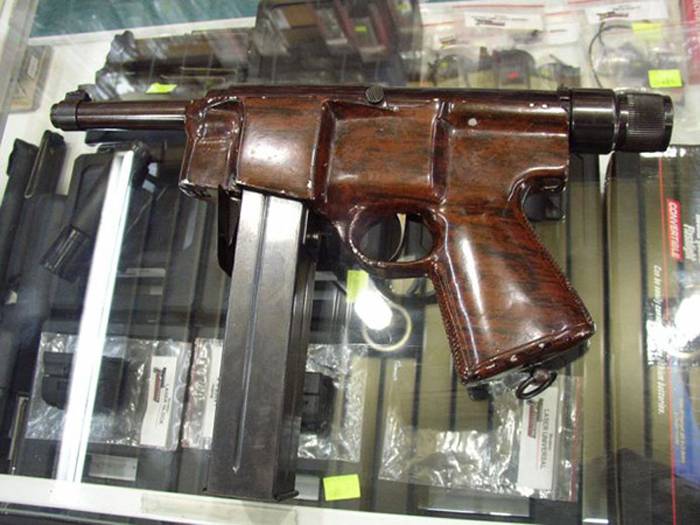 The only known sample of the C-2, now a museum piece.
The only known sample of the C-2, now a museum piece.
HAFDASA created its own line of submachine guns in 1938 year. At the same time, prototypes of three types were tested., as a result of which the weapon could be adopted by the army or the police. As far as, the weapons presented received mixed ratings. Compact sample C-2 could not interest the military and law enforcement, while the other two submachine guns soon became the subject of new orders.
However, according to some sources, the development company still released a small pre-production batch of new weapons. It included no more than 35-40 products. Why did they make this weapon, and who ordered it is unknown. maybe, despite the well-known skepticism, potential buyers decided to check the proposed sample as part of trial operation. However, even the use of the received submachine guns did not have a noticeable effect on the opinion of the command.. After the transfer of the pre-production batch, production did not resume.
The further fate of most of the prototypes and pre-production samples is unknown.. Apparently, these weapons, not needed by potential customers and manufacturer, later smelted. Only one surviving specimen is reliably known.. Now this product, using, According to available data, chuck 9x19 mm, kept in one of the Argentine museums. among other things,, this sample is interesting for its finish. The aluminum stock of the submachine gun was painted wood-like in brown and black. Submachine guns chambered for .45 ACP, apparently, not preserved.
In the thirties of the last century, the Argentine command studied the subject of submachine guns and looked for a sample, usable. First project X. Lenara was not interested in the military, because of what the rearmament of the army was postponed indefinitely. A few years later, Hispano-Argentina Fábrica de Automóviles S.A. offered three promising samples at once. The compact C-2 submachine gun also did not interest potential customers and was released only in a small pre-production batch.. The other two projects turned out to be more successful and were able to reach full-fledged operation in different structures..











